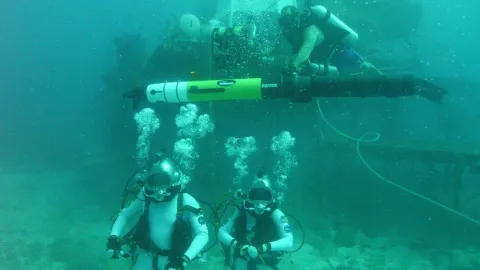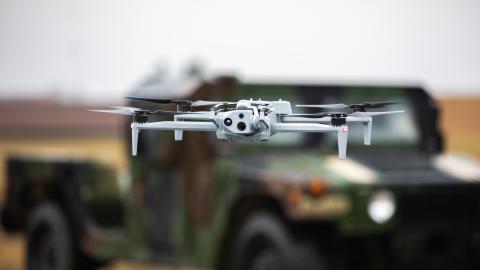It often seems that every landmark victory in Mexico's war against organized crime is followed by a demoralizing or embarrassing setback. In December 2009, for example, Mexican naval forces killed Arturo Beltrán Leyva, one of the country's most notorious drug kingpins, after a two-hour firefight that also claimed the life of a courageous marine named Melquisedet Angulo, who was subsequently honored as a national hero.
Less than a week later, vengeful cartel gunmen brutally murdered Angulo's mother, his aunt and two of his siblings. More recently, in October 2012, the navy killed Heriberto Lazcano, boss of the spectacularly violent Zetas cartel. But then Lazcano's corpse was stolen from a funeral home by armed intruders. On July 15, the navy captured Lazcano's successor, Miguel Ángel Treviño, the most vicious drug lord in Mexico, without firing a shot. Unfortunately, the arrest of Treviño was quickly overshadowed by a surge of violence in the western state of Michoacán, including the July 28 killing of Vice Admiral Carlos Miguel Salazar, a senior naval official.
According to the Associated Press, the deadly attack on Salazar's SUV was apparently "the result of a series of tragic coincidences rather than a planned, targeted assassination." It was carried out by members of the Knights Templar cartel, an organization formed in 2011 after the destruction of a previous Michoacán-based cartel known as La Familia. In recent weeks, Knights Templar gunmen have killed several police officers, and on July 22 they slaughtered five peaceful demonstrators in the town of Los Reyes. The gang has also orchestrated street protests against government security forces. When Salazar's car ran into a traffic jam caused by such a protest, the vice admiral decided to search for a different route back to his naval station. This led him down a rural side road, where he was ambushed.
Following the Treviño arrest, many foreign observers might have been tempted to say that Mexico was winning the cartel war. Following the murder of Vice Admiral Salazar and the related bloodshed in Michoacán, it is tempting to say that Mexico is losing the war. The truth is more complicated.
In a recent Bloomberg piece, former Mexican intelligence officer Alejandro Hope offered what is probably the most accurate summary of where things stand: "While Mexico's fight against crime is moving in the right direction, it is doing so at a haltingly slow pace, much as it was a year ago."
The biggest problem, obviously, is the persistently high level of violence, although there is evidence that Mexico has made progress in reducing drug-related killings. A University of San Diego study found that, depending on which data source we consult, murders linked to organized crime either plateaued or fell significantly last year. For that matter, the Mexican government has reported that organized-crime killings declined by 18 percent between December 2012 and May 2013, compared with the prior six months. Yet researchers at the nonprofit Mexican Institute of Competitiveness estimate that the seasonally adjusted decline in all Mexican homicides between December and May was only 6 percent. That is still progress, of course, but the plain fact is that Mexico has a much higher murder rate today than it did when President Felipe Calderón deployed the military against the cartels back in December 2006. The violence is especially bad in Michoacán, in the neighboring state of Guerrero and in the border state of Coahuila.
Violence also remains high in the border state of Chihuahua. However, the state's largest city, Juárez, a onetime global murder capital, has witnessed a precipitous drop in drug-related violence. To be sure, the security gains in Juárez are partly -- perhaps even largely -- the result of one criminal organization (the Sinaloa cartel) either defeating or reaching a tentative truce with another (the Juárez cartel) in their battle for territorial control. But the city has also benefited from police reforms and social programs, including various initiatives undertaken by Chihuahua Governor César Duarte.
For most of Mexico, state and local police reform is moving at a snail's pace. The same can be said of judicial reform, despite the major constitutional changes that were enacted in 2008. The most substantial police reforms have come in the state of Nuevo León (northeastern Mexico), while the most aggressive criminal justice reforms have taken place in Chihuahua, the state of Mexico (which surrounds Mexico City), and Morelos (which borders both Mexico state and Mexico City). There have also been significant judicial reforms in the states of Oaxaca (southwestern Mexico) and Zacatecas (north-central Mexico).
Mexican President Enrique Peña Nieto, who took office in December, has pledged to make judicial reform a top priority. As for the rest of his security agenda, Peña Nieto has indicated that he will reduce U.S. access to Mexican territory and Mexican intelligence, thereby reversing some of Calderón's policies. In general, he has downplayed talk of the drug war and drawn attention to Mexico's economic strengths.
And yet, the Treviño operation confirmed that U.S.-Mexico security cooperation will likely remain robust. According to Mexican-American scholar Ricardo Ainslie, author of "The Fight to Save Juárez," the Zeta leader was "tracked in real time by a U.S. Immigration and Customs Enforcement drone, while American intelligence monitored his communications and shared what was learned with Mexican authorities." Meanwhile, as InSight Crime analyst Patrick Corcoran has noted, the Mexican marines who arrested the Zeta leader were following his car in a U.S.-supplied Black Hawk helicopter.
With the capture of Treviño, 26 of the 37 drug lords identified by the Mexican government in March 2009 are now either dead or in prison. Twenty-five of those kingpins were taken out under President Calderón, who has been unjustly vilified for adopting policies that were necessary to establish the rule of law.
Indeed, when Calderón assumed the presidency in December 2006, five massively powerful cartels were threatening to turn Mexico into a narco-state. The country was already in the midst of an historic security crisis, with drug-related murders shooting up by nearly nine percent in 2005 and by nearly eleven percent in 2006, according to Harvard's Viridiana Ríos. News reports in December 2006 spoke of "escalating violence between warring drug cartels" (Associated Press) and said that certain regions of Mexico were "virtually paralyzed with tension" (Los Angeles Times), with border cities becoming "war zones" (San Antonio Express-News). Given the pervasive corruption at all levels of Mexican policing, Calderón had no choice but to unleash the military while simultaneously building a new and improved federal police force.
Over the past seven years, all five of Mexico's largest 2006-era cartels have splintered, and one of them (La Familia) has been destroyed entirely. The Gulf, Juárez, and Tijuana cartels are all much less powerful and much more divided than they were a decade ago. The Zetas, who were part of the Gulf cartel until splitting off in 2010, remain Mexico's most violent criminal gang, but the government has now captured or killed four of the five most-wanted Zeta leaders it identified in 2009. The organization began fracturing last year, and the arrest of Treviño will further damage its internal cohesion. The Sinaloa cartel is still the country's biggest criminal enterprise, but its most lethal offshoot, the Beltrán Leyva cartel, was dismantled in 2010.
Not only has Mexico destroyed or seriously weakened most of the biggest cartels, it has also established a cleaner, more effective federal police force, while greatly improving its intelligence capabilities. The downside is that, by destabilizing and rupturing the cartels, Mexican authorities have created a more volatile and competitive criminal environment with higher levels of violence. Whereas the drug trade was once dominated by a handful of giant organizations, Mexican Attorney General Jesús Murillo believes there are now dozens of small or medium-sized trafficking groups. Unlike the larger, older cartels, these newer drug gangs cannot threaten the state itself, but they can generate enormous amounts of bloodshed.
Mexican police forces are not yet capable of handling the violence themselves; they still need military assistance. For all the criticism of Calderón's strategy, it's worth noting that, according to a March 2013 Pew Research Center survey, 85 percent of Mexicans still support using the army to battle the cartels. There is certainly a danger in becoming too reliant on the military, and Peña Nieto must not neglect the federal police. He must also do more than Calderón did to accelerate police and judicial reforms at the state and local levels. But as recent events have shown, the military remains an essential tool in Mexico's struggle against organized crime.
Given all that, is the Mexican government winning or losing the cartel war? Despite the terrible violence, the government is indeed winning. But transforming Mexico into a rule-of-law society will take many years. Anyone expecting rapid progress is likely to be disappointed.













